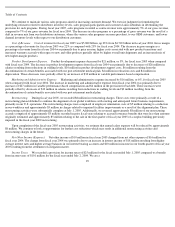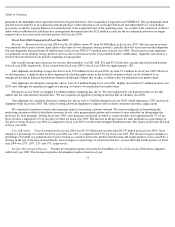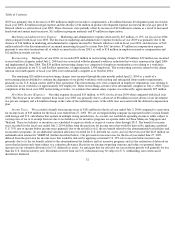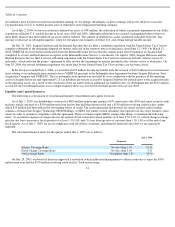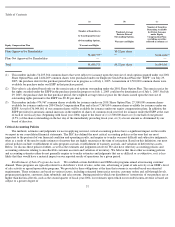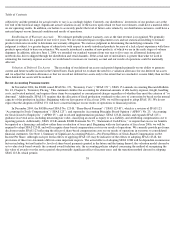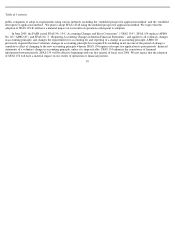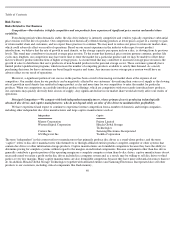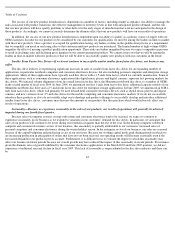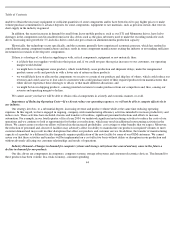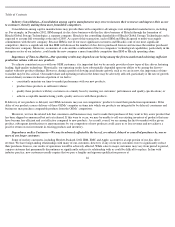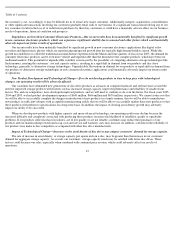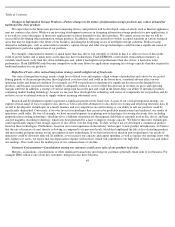Seagate 2004 Annual Report Download - page 41
Download and view the complete annual report
Please find page 41 of the 2004 Seagate annual report below. You can navigate through the pages in the report by either clicking on the pages listed below, or by using the keyword search tool below to find specific information within the annual report.
Table of Contents
subjectivity and the potential for actual results to vary is accordingly higher. Currently, our distributors’ inventories of our products are at the
low end of the historical range. Significant actual variations in any of the factors upon which we base our estimates could have a material effect
on our operating results. In addition, our failure to accurately predict the level of future sales returns by our distribution customers could have a
material impact on our financial condition and results of operations.
Establishment of Warranty Accruals. We estimate probable product warranty costs at the time revenue is recognized. We generally
warrant our products for a period of one to five years. We use estimated repair or replacement costs and use statistical modeling to estimate
product return rates in order to determine our warranty obligation. We exercise judgment in determining the underlying estimates. Our
judgment is subject to a greater degree of subjectivity with respect to newly introduced products because of a lack of past experience with those
products upon which to base our estimates. We recently introduced a number of new products, of which we are in the early stages of volume
shipment. In addition, effective June 1, 2004, we extended our standard warranty from one year to five years on all internal desktop and
notebook disc drives shipped through the distribution and retail channels. If the actual rate of unit failures is greater than what we used in
estimating the warranty expense accrual, we would need to increase our warranty accrual and our results of operations could be materially
affected.
Valuation of Deferred Tax Assets. The recording of our deferred tax assets each period depends primarily on our ability to generate
current and future taxable income in the United States. Each period we evaluate the need for a valuation allowance for our deferred tax assets
and we adjust the valuation allowance so that we record net deferred tax assets only to the extent that we conclude it is more likely than not that
these deferred tax assets will be realized.
Recent Accounting Pronouncements
In November 2004, the FASB issued SFAS No. 151, “Inventory Costs” (“SFAS 151”). SFAS 151 amends Accounting Research Bulletin
No. 43, Chapter 4,
“Inventory Pricing.” This statement clarifies the accounting for abnormal amounts of idle facility expense, freight, handling
costs, and wasted material, and requires those items be recognized as current period charges regardless of whether they meet the criterion of “
so
abnormal.”
Additionally, SFAS 151 requires that the allocation of fixed production overheads to the costs of conversion be based on the normal
capacity of the production facilities. Beginning with our first quarter of fiscal year 2006, we will be required to adopt SFAS 151. We do not
expect that the adoption of SFAS 151 will have a material impact on our results of operations or financial position.
In December 2004, the FASB issued SFAS No. 123-R, “Share-Based Payment” (“SFAS 123-R”), which is a revision of SFAS 123,
“Accounting for Stock Compensation” (“SFAS 123”), and supersedes Accounting Principles Board Opinion (“APBO”) No. 25, “Accounting
for Stock Issued to Employees” (“APBO 25”), and its related implementation guidance. SFAS 123-R clarifies and expands SFAS 123’s
guidance in several areas, including measuring fair value, classifying an award as equity or as a liability, and attributing compensation cost to
reporting periods. Additionally, SFAS 123-R amends FASB Statement No. 95, “Statement of Cash Flows,” to require that excess tax benefits
be reported as a financing cash inflow rather than as reduction of taxes paid. Beginning with our first quarter of fiscal year 2006, we will be
required to adopt SFAS 123-R, and will recognize share-
based compensation costs in our results of operations. We currently provide pro forma
disclosures under SFAS 123 reflecting the effects of share-based compensation costs on our results of operations in our notes to consolidated
financial statements. See Note 1, Summary of Significant Accounting Policies—Pro Forma Effects of Stock-Based Compensation on Net
Income Per Share. Although such pro forma effects of applying SFAS 123 may be indicative of the effects of adopting SFAS 123-R, the
provisions of these two statements differ in some important respects. The actual effects of adopting SFAS 123R will be dependent on numerous
factors including, but not limited to, levels of share-
based payments granted in the future and the timing thereof; the valuation model chosen by
us to value stock-based awards; the assumed award forfeiture rate; the accounting policies adopted concerning the method of recognizing the
fair value of awards over the service period; the potentially significant effect of income taxes; and the transition method chosen for adopting
SFAS 123-R, which permits
38



